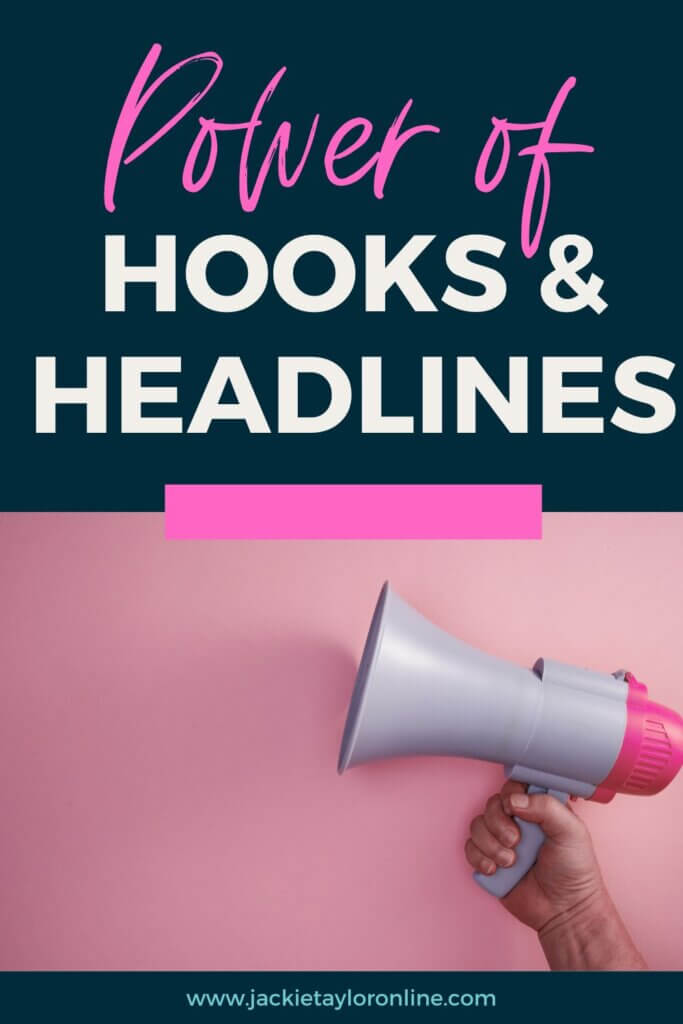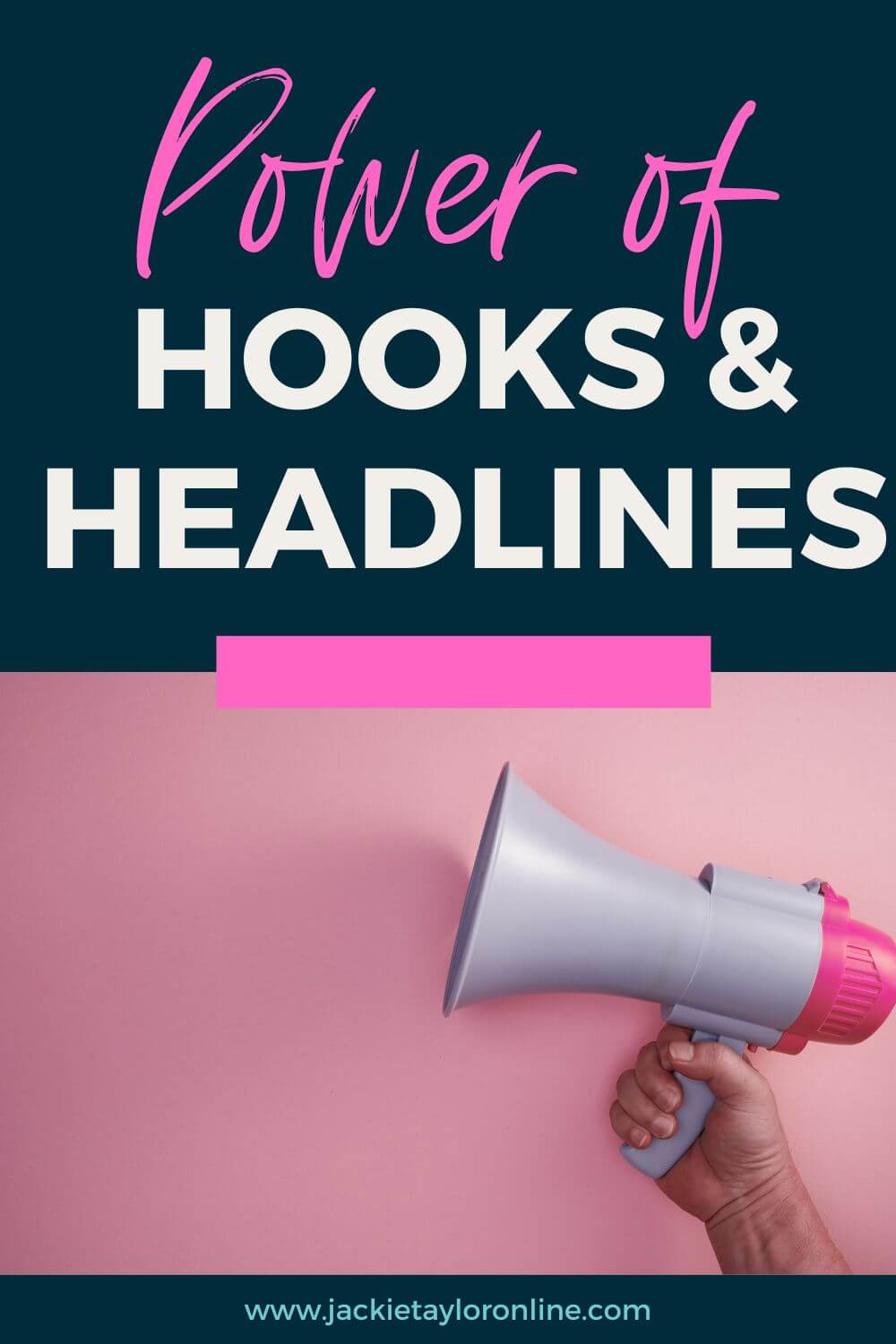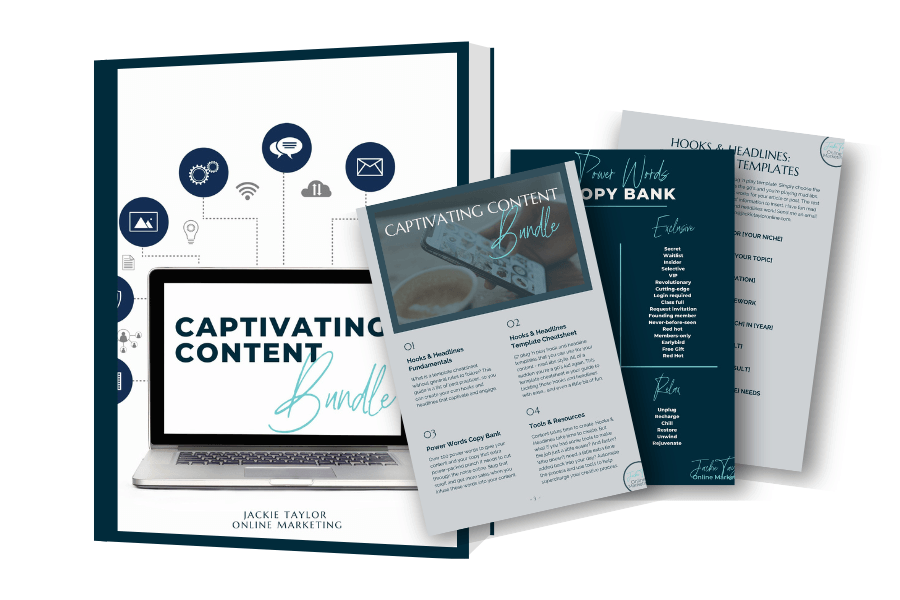Hooks and headlines: how can you get anyone’s attention? Especially since everyone is so distracted all day long. They face interruptions from text messages, push notifications, and emails. People even find themselves mindlessly scrolling on social media.
Nowadays, you need a hook that’s going to reach out and slap them right in the face!
So, whether you’re writing a blog post, a social media hook or caption, or a video script, the first few seconds are crucial in determining whether or not your reader will stick with you. That’s where hooks and headlines come in.
So, let’s break them down for you, so you can create better hooks that very nearly slap your audience right in the face.
AFFILIATE DISCLAIMER: I SOMETIMES LINK TO PRODUCTS AND SERVICES TO HELP COVER THE COSTS OF RUNNING THIS BLOG. THERE’S NO EXTRA COST TO YOU – AND I ONLY RECOMMEND PRODUCTS THAT I’VE BOTH USED PERSONALLY AND THINK ARE QUALITY PRODUCTS THAT HELP WITH EFFICIENCY. PLEASE READ MY AFFILIATE DISCLOSURE FOR MORE INFORMATION. THANKS FOR YOUR SUPPORT!
Table of Contents
What are Hooks and Headlines?
A hook is a sentence or phrase that grabs the reader’s attention and makes them want to read more. It’s typically the first sentence of a piece of content and is designed to be intriguing and engaging. A headline, on the other hand, is the title of the piece of content and is designed to give the reader a clear idea of what the content is about.

The Importance of Hooks and Headlines:
When it comes to using hooks and headlines, it’s important to strike a balance between being intriguing and being clear. A hook that is too vague or mysterious may not entice the reader to read on, while a headline that is too long or convoluted may not give the reader a clear idea of what the content is about.
A good rule to follow? Always choose being clear over being clever. If you’re unsure if your audience will understand your cleverness, they probably won’t. But that doesn’t mean you can’t add a little pizzazz every now and then.
Hooks and Headlines Tips:
1. Use Power Words:
To create a strong hook, consider using power words. These are words that have emotional impact and are designed to elicit a specific response in the reader. For example, words like “secret,” “proven,” and “exclusive” can create a sense of intrigue and make the reader feel like they’re getting special access to something. Other power words, such as “free,” “new,” and “you,” can create a sense of urgency and encourage the reader to take action. Want more power words? Grab the Captivating Content Bundle with a copy bank of over 100 Power Words. More details at the end of the article.
2. Be Specific:
When it comes to headlines, use action words and be as specific as possible. Headlines that are too general or vague may not capture the reader’s attention. Instead, use specific numbers, statistics, and facts to create a sense of urgency and to make your headline stand out. Also, try to make your headline as short and to the point as possible.
3. Use a Question:
Another effective technique for creating hooks and headlines is to use a question. Questions can create curiosity and encourage the reader to read on to find the answer. Make sure your question is relevant to the content and is something the reader would be interested in.
4. Add a Benefit:
Lastly, consider adding a benefit to your headline. This is a statement that explains what the reader will gain from reading the content. For example, “5 Tips for Boosting Your Productivity” or “10 Ways to Save Money on Your Grocery Bill”. Benefits can create a sense of value and make the reader more likely to continue reading.
Headline Examples
And to get you started, here are a few headline examples that you can copy to use right now. Copy them into a Notion document to save for later and you always have a start to your blog posts, podcast episodes, videos, social media hooks, and more:
- How I [End Result]: My Exact Framework (Example: How I Increased Blog Traffic by 5,000: My Exact Framework)
- [Desired End Result] with This 1 Secret (Example: 3X your traffic with this 1 secret)
- This Will Keep You [Undesired Result] (Example: This Will Keep You Stuck with No Traffic)
- The Number 1 Way to [Desired Result] (Example: The Number 1 Way to Increase Conversions)
- I’m Going to Tell You Something No Other [Your Industry] is Going to Tell You… (Example: I’m Going to Tell You Something No Other Content Strategist is Going to Tell You…)
- How to [Desired Result] [Where] in [Timeframe] (Example: How to Get More Blog Traffic on Your Website in 3 Months)
- 🔥 Hot Take: [Unpopular Opinion] (Example: 🔥 Hot Take: You Don’t Need Social Media to Grow Your Business)
- [X] of the Best [Thing] That You Aren’t Using (but Should Be) [Example: 10 of the Best Content Tools That You Aren’t Using (but Should Be)]
- Why I [Something You Do Daily] (Example: Why I Record B Roll Daily)
Conclusion:
Hooks and headlines are both critical elements of any piece of content. A hook is a sentence or phrase that grabs the reader’s attention and makes them want to read more, while a headline is the title of the piece of content and is designed to give the reader a clear idea of what the content is about. To use hooks and headlines effectively, it’s important to strike a balance between being intriguing and being clear, and to use power words, specific numbers and statistics, questions, and benefits. By doing so, you’ll be able to grab and keep your reader’s attention, and ultimately achieve your desired outcome.
Captivating Content Bundle
Ready to create even more hooks and headlines? Scoop up the Captivating Content Bundle that includes 57 plug n’ play hooks and headlines templates (just like the free ones above) to fill in mad libs style. Plus, a Power Word bank of over 100 power words to infuse into your copy, and my (tested and proven) tips for creating hooks and headlines that reach out and slap your audience… or very close to it! It’s your guide to creating content that *actually* gets noticed.
Related Articles
Master Pillar Content: How to Pick Your Pillars with Examples
The Buyers Journey: How to Create Content That Guides Your Audience to Purchase
40+ Online Marketing Resources: You Don’t Want to Miss
How to Financially Be a Stay at Home Mom
Customer Research Methods: 4 Ways to Get Inside Your Audience’s Mind


+ show Comments
- Hide Comments
add a comment